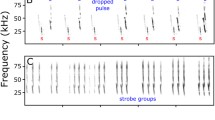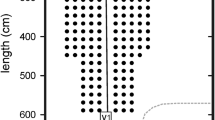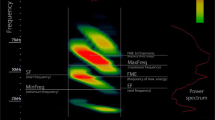Abstract
Echolocating bats adjust the time–frequency structure such as sweep rate and pulse interval of their sonar calls when they move from open space to vegetation-dense environments. Emitted call intensity is equally important for echolocation, but adjustment of signal intensity to different habitats has never been systematically studied in any bat species. To address this question, we recorded sonar calls of the Neotropical trawling insectivorous bat Macrophyllum macrophyllum (Phyllostomidae) at three sites with different obstacle densities (clutter). We found a clear correlation between emitted intensity and degree of clutter, with intensity proportional to decreasing clutter. In highly cluttered, semicluttered, and open spaces, M. macrophyllum emitted calls with mean source levels (sound pressure level (SPL) 10 cm from the bat’s mouth) of 100, 105, and 111 dB SPL root mean square (rms), respectively. To our knowledge, this is the first documentation of dynamic intensity adjustments in bats. Phyllostomid bats were previously considered silent, but the 111-dB SPL rms emitted by free-ranging M. macrophyllum in open space is comparable to output in aerial insectivorous bats from other families. Our results suggest that the acoustic constraints of habitats are better predictors of call intensity than phylogeny and therefore likely to be major drivers shaping the sonar system of bats in the course of evolution.




Similar content being viewed by others
Explore related subjects
Discover the latest articles and news from researchers in related subjects, suggested using machine learning.Abbreviations
- SPL:
-
Sound pressure level
- SL:
-
Source level
References
ANSI (1978) American National Standard. Method for the calibration of the absorption of sound by the atmosphere. ANSI S1 26-1978. Standards Secretariat. Acoustical Society of America. 335 East 45th Street, New York, NY 10017, USA. American Institute of Physics for the Acoustical Society of America
Boonman A, Jones G (2002) Intensity control during target approach in echolocating bats; stereotypical sensori-motor behaviour in Daubenton’s bats, Myotis daubentonii. J Exp Biol 205:2865–2874
Brinkløv S, Surlykke A, Kalko EKV (2009) Intense echolocation calls from two “whispering” bats, Artibeus jamaicensis and Macrophyllum macrophyllum (Phyllostomidae). J Exp Biol 212:11–20
Fenton MB (1990) The foraging behaviour and ecology of animal-eating bats. Can J Zool 68:411–422
Fenton MB, Acharya L, Audet D, Hickey MBC, Merriman C, Obrist MK, Syme DM, Adkins B (1992) Phyllostomid bats (Chiroptera: Phyllostomidae) as indicators of habitat disruption in the Neotropics. Biotropica 24(3):440–446
Griffin DR (1944) Echolocation by blind men, bats and radar. Science 100:589–590
Harrison DL (1975) Macrophyllum macrophyllum. Mamm species 62:1–3
Holderied MW, von Helversen O (2003) Echolocation range and wingbeat period match in aerial-hawking bats. Proc R Soc Lond B 270:2293–2299
Jensen ME, Miller LA (1999) Echolocation signals of the bat Eptesicus serotinus recorded using a vertical microphone array: effect of flight altitude on searching signals. Behav Ecol Sociobiol 47:60–69
Jensen ME, Moss CF, Surlykke A (2005) Echolocating bats can use acoustic landmarks for spatial orientation. J Exp Biol 208:4399–4410
Jones G, Rayner JMV (1988) Flight performance, foraging tactics and echolocation in free-living Daubenton’s bats Myotis daubentonii (Chiroptera, Vespertilionidae). J Zool 215:113–132
Kalko EKV (1995) Insect pursuit, prey capture and echolocation in pipistrelle bats (Microchiroptera). Anim Behav 50:861–880
Kalko EKV, Schnitzler H-U (1993) Plasticity in echolocation signals of European pipistrelle bats in search flight: implications for habitat use and prey detection. Behav Ecol Sociobiol 33(6):415–428
Kalko EKV, Schnitzler H-U, Kaipf I, Grinnel AD (1998) Echolocation and foraging behavior of the lesser bulldog bat, Noctilio albiventris: adaptations for piscivory? Behav Ecol Sociobiol 42:305–319
Korine C, Kalko EKV (2005) Fruit detection and discrimination by small fruit-eating bats (Phyllostomidae): echolocation call design and olfaction. Behav Ecol Sociobiol 59:12–23
Meyer C, Weinbeer M, Kalko EKV (2005) Home range size and spacing patterns of Macrophyllum macrophyllum (Phyllostomidae) foraging over water. J Mamm 86(3):587–598
Miller LA, Treat AE (1993) Field recordings of echolocation and social signals from the gleaning bat Myotis septentrionalis. Bioacoustics 5:67–87
Mora EC, Macías S (2007) Echolocation calls of Poey’s flower bat (Phyllonycteris poeyi) unlike those of other phyllostomids. Naturwissenschaften 94:380–383
Neuweiler G (1990) Auditory adaptations for prey capture in echolocating bats. Physiol rev 70(3):615–641
Novick A (1977) Acoustic orientation. In: Wimsatt WA (ed) Biology of bats, vol 3. Academic, New York, pp 74–289
Schaub A, Schnitzler H-U (2007) Echolocation behavior of the bat Vespertilio murinus reveals the border between the habitat types ‘edge’ and ‘open space’. Behav Ecol Sociobiol 61:513–523
Schnitzler H-U, Kalko EKV (2001) Echolocation by insect-eating bats. Bioscience 51:557–569
Schnitzler H-U, Kalko EKV, Kaipf I, Grinnell AD (1994) Fishing and echolocation behavior of the greater bulldog bat, Noctilio leporinus, in the field. Behav Ecol Sociobiol 35:327–345
Simmons NB (2005) An Eocene big bang for bats. Science 307:527–528
Simmons JA, Lavender WA, Lavender BA, Childs JE, Hulebak K, Rigden MR, Sherman J, Woolman B, O’Farrell MJ (1978) Echolocation by free-tailed bats (Tadarida). J comp Physiol 125:291–299
Surlykke A, Bojesen O (1996) Integration time for short broad band clicks in echolocating FM-bats (Eptesicus fuscus). J Comp Physiol A 178:235–241
Surlykke A, Kalko EKV (2008) Echolocating bats cry out loud to detect their prey. PLoS ONE 3(4):e2036. doi:10.1371/journal.pone.0002036
Surlykke A, Moss CF (2000) Echolocation behavior of big brown bats, Eptesicus fuscus, in the field and the laboratory. J Acoust Soc Am 108(5):2419–2429
Surlykke A, Miller LA, Møhl B, Andersen BB, Christensen-Dalsgaard J, Jørgensen MB (1993) Echolocation in two very small bats from Thailand: Craseonycteris thonglongyai and Myotis siligorensis. Behav Ecol Sociobiol 33:1–12
Surlykke A, Filskov M, Fullard JH, Forrest E (1999) Auditory relationships to size in Noctuid moths: bigger is better. Naturwissenschaften 86:238–241
Surlykke A, Pedersen SB, Jakobsen L (2009) Echolocating bats emit a highly directional sonar sound beam in the field. Proc R Soc B 276:853–860
Suthers RA (1967) Comparative echolocation by fishing bats. J Mamm 48(1):79–87
Thies W, Kalko EKV, Schnitzler H-U (1998) The roles of echolocation and olfaction in two Neotropical fruit-eating bats, Carollia perspicillata and C. castanea, feeding on Piper. Behav Ecol Sociobiol 42:397–409
von Helversen O, Winkler L, Bestmann HJ (2000) Sulphur-containing “perfumes” attract flower-visiting bats. J Comp Physiol 186(2):143–153
Weinbeer M, Kalko EKV (2007) Ecological niche and phylogeny: the highly complex echolocation behavior of the trawling long-legged bat, Macrophyllum macrophyllum. Behav Ecol Sociobiol 61(9):1337–1348
Weinbeer M, Meyer CFJ, Kalko EKV (2006) Activity pattern of the trawling phyllostomid bat, Macrophyllum macrophyllum, in Panamá. Biotropica 38(1):69–76
Wilson WW, Moss CF (2004) Sensory-motor behavior of free-flying FM bats during target capture. In: Thomas JA, Moss CF, Vater M (eds) Echolocation in bats and dolphins. The University of Chicago Press, Chicago, pp 22–27
Winter Y, Lopez J, von Helversen O (2003) Ultraviolet vision in a bat. Nature 425:612–614
Acknowledgments
Research was funded by the Danish Natural Science Research foundation (to A. S. and S. B.), the Wissenschaftskolleg zu Berlin (fellowship support of A.S.), and the Smithsonian Tropical Research Institute (STRI) and the German Science Foundation (DFG; to E.K.V.K.). We thank Jakob Christensen-Dalsgaard and John Ratcliffe for comments on previous manuscript versions and two anonymous reviewers for helpful suggestions. We also thank Christian Brandt for positioning software, Ulrik Nørum for help with statistic analysis, and STRI and Isla Barro Colorado staff for excellent research facilities. Research complied with laws of Panamá and IACUC regulations of STRI.
Conflict of interest
The authors declare that they have no conflict of interest.
Author information
Authors and Affiliations
Corresponding author
Additional information
Communicated by: G. Jones
Rights and permissions
About this article
Cite this article
Brinkløv, S., Kalko, E.K.V. & Surlykke, A. Dynamic adjustment of biosonar intensity to habitat clutter in the bat Macrophyllum macrophyllum (Phyllostomidae). Behav Ecol Sociobiol 64, 1867–1874 (2010). https://doi.org/10.1007/s00265-010-0998-9
Received:
Revised:
Accepted:
Published:
Issue Date:
DOI: https://doi.org/10.1007/s00265-010-0998-9




